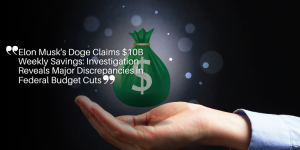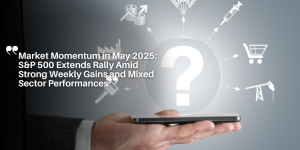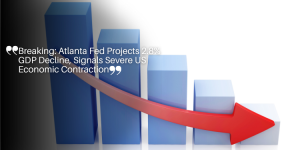Breaking: February Retail Sales Rebound Signals Moderate US Economic Growth
February Retail Sales Show Signs of Recovery
U.S. retail sales have shown a modest increase of 0.2% in February 2025, according to the latest report from the Department of Commerce.
This slight rebound comes after a revised decline of 1.2% in January, painting a mixed picture of economic trends as we progress through the first quarter.
Initially, January’s decline was reported at 0.9%, but the figures were adjusted to reflect the broader impact of earlier gains in the fourth quarter, combined with adverse weather conditions such as winter storms and California wildfires.

Economists’ Predictions vs. Actual Performance
Economists had anticipated a more robust recovery in retail sales for February, projecting an increase of 0.6%.
The shortfall against these expectations highlights the uncertainties currently twisting the economic landscape.
Factors such as the tariffs imposed by the Trump administration continue to spark concerns regarding inflation, which in turn may lead to cautious consumer behavior as fears of job and income losses persist.
Consumer Confidence and Spending
A key obstacle to the anticipated retail sales boost is the dip in consumer confidence. March figures show consumer confidence hitting its lowest point in two and a half years, which does not bode well for sustaining momentum in consumer spending.
The precarious balance of maintaining economic growth amidst these concerns underlines how delicate the situation is for both consumers and businesses alike.
Context of Broader Economic Trends
Despite the challenges, there are still positive signals within the retail sector. Retail sales, excluding volatile categories such as automobiles, gas, construction materials, and food services, rose by 1.0% in February.
This increase is significant as it aligns closely with the GDP’s consumer spending component, indicating a moderate growth trajectory despite the hurdles.
As we navigate through these uncertain waters, it is important to keep an eye on how consumer confidence, government policies, and environmental factors play out.
These elements collectively shape the broader economic outlook and will determine the pace at which the economy continues to grow.
Factors Affecting Consumer Confidence
- 📈Consumer confidence is a crucial factor in determining retail spending patterns. In March 2025, consumer confidence hit its lowest point in two and a half years.
- 📈This decline has sparked worries about the ongoing rise in retail sales.
Impact of Natural Disasters on Retail Figures
✅ The winter storms and California wildfires that affected significant parts of the U.S. in January played a substantial role in distorting retail figures.
✅ January’s extreme weather conditions created various challenges for both supply chains and consumer behavior, leading to a notable 1.2% decline in retail sales for the month.
✅ The weather disruptions caused delays in deliveries and resulted in reduced foot traffic in many retail stores. In areas affected by the wildfires, residents were more focused on emergency preparedness and home safety, resulting in a slowdown in usual consumer spending.
Economic Anxiety from Tariffs
- 📈Further compounding the drop in consumer confidence are the continuing impacts of the Trump administration’s trade war policies.
- 📈The imposition of various tariffs has heightened concerns surrounding inflation and job security among American consumers.
- 📈With tariffs raising the costs of imported goods, the financial strain on households has been significant, adding to the fear of price hikes on everyday items.
- 📈Inflation worries are not just about the immediate price increases but also about the long-term economic stability.
- 📈Households are understandably anxious about future income and job security, which translates into more cautious spending habits.
- 📈These sentiments create an atmosphere where even those who have remained employed or financially secure still feel the need to save rather than spend, further flattening the consumer confidence index.
Government Policy and Consumer Behavior
The federal workforce reduction policies implemented by the Trump administration have also contributed to a decline in consumer spending.
Drastic cuts to the federal workforce have directly impacted thousands of government employees, many of whom face job loss or uncertainty regarding their employment status.
These workers are curbing their spending due to the palpable threat of unemployment, which echoes through the wider economy. The fear of further workforce reductions keeps dampening the optimism, even among those not directly affected.
Looking Forward
The combination of these factors suggests a cautious outlook for future retail performance. With consumer confidence dipping to new lows, the modest recovery in retail sales observed in February might not be sustainable in the coming months.
The lingering effects of natural disasters, combined with economic and policy-induced insecurities, present significant roadblocks to maintaining positive momentum in consumer spending.
However, understanding these patterns is essential for navigating the complexities of economic growth and stability in this uncertain environment.
Government Policy Impact on Spending
The effects of government policies on consumer confidence and spending can be significant, particularly in an economy as dynamic as the United States.
President Trump’s administration has been characterized by aggressive trade policies and efforts to reduce the size of the federal workforce, both of which have had wide-reaching impacts on consumer behavior and economic outlook.
Trade War Policies and Consumer Behavior
One of the most notable policies under the Trump administration has been the implementation of tariffs on a range of imported goods.
These tariffs have triggered what has been widely referred to as a trade war, with several countries, including China, retaliating with their own tariffs. The impact on consumers has been substantial, with worries about inflation taking center stage.
Higher prices on imported goods mean that consumers may find themselves paying more for everyday items, which can become a burden on their budgets. lead to reduced spending in other areas.
This ripple effect can stymie economic growth, as seen in the February retail sales figures that showed a modest 0.2% increase after a sharp 1.2% decline in January.
Additionally, concerns about job security and potential income loss due to the trade war have made consumers more cautious.
Employers facing higher costs may reduce hiring or lay off workers, which further dampens consumer spending. The overall result is a major hit to consumer confidence, which reached a 2.5-year low in March.
Federal Workforce Reduction
Another impactful policy has been the Trump administration’s campaign to reduce the size of the federal workforce.
The goal of this policy is to save money and streamline government operations, but it comes with its own set of challenges.
The layoffs and hiring freezes within federal agencies have a direct impact on the spending habits of government employees.
With fewer employees and more uncertainty about job security, discretionary spending tends to decrease. This reduction in spending can be seen in various sectors, including retail, where there is less demand for goods and services.
The broader economic impact is also notable. Federal employees are a significant part of the consumer base, and their reduced spending can lead to lower sales for businesses and, ultimately, slower economic growth.
Tariffs and Economic Concerns
The imposition of tariffs doesn’t just affect consumer prices. It also raises concerns about broader economic impacts, particularly potential job and income loss.
For businesses that rely on imported materials or goods, higher tariffs can translate to higher operational costs. These businesses may respond by cutting jobs, reducing wages, or passing the increased costs onto consumers.
When businesses tighten their belts, it creates an atmosphere of uncertainty. Consumers who fear job loss or reduced income are less likely to spend money on non-essential items, leading to slower growth in the retail sector and beyond.
This cycle of reduced spending further perpetuates economic challenges, often leading to a more cautious approach by consumers across the board.
Summing Up the Impact of Policies
Overall, the Trump administration’s trade policies and workforce reduction efforts have contributed to a climate of economic uncertainty.
These policies have stoked fears about inflation and job security, leading to more cautious consumer behavior and a muted retail environment.
As the economy continues to grow at a moderate pace, ongoing concerns related to these policies and external factors, such as natural disasters, underscore the complex landscape for future growth.
Transitioning from this, it’s essential to understand how these economic challenges align with core retail performance metrics and what they suggest for the upcoming economic outlook.
Core Retail Performance Metrics
- 📈While the broader retail sales data experienced only a 0.2% increase in February after a 1.2% decline in January, core retail sales tell a slightly more encouraging story.
- 📈Excluding the more volatile categories such as automobiles, gasoline, construction materials, and food services, core retail sales rose by 1.0% in February.
- 📈This uptick offers a glimpse into the ongoing spending habits of consumers on essential goods and services. The increase aligns well with the consumer spending component of the Gross Domestic Product (GDP), suggesting some hidden strength in the consumer sector.
Detailed Breakdown
The 1.0% rise in core retail sales indicates a moderate growth trajectory despite the broader economic challenges.
This segment of retail sales is considered more stable and provides a better long-term outlook for consumer spending.
The alignment of these metrics with the GDP consumer spending component is crucial for understanding the overall economic impact.
Economic Indicators
Even though consumer confidence has hit a low and overall retail sales growth remains modest, the 1.0% rise in core retail figures suggests that consumers continue to spend on essential items.
This provides hope that despite external factors like tariffs and the downsizing of the federal workforce, the economy retains a level of resilience.
It’s worth noting that core retail sales are less susceptible to the fluctuations seen in categories like automobiles and gasoline, making them a more reliable economic indicator.
Growth Amidst Challenges
- 📈The path ahead is fraught with challenges. The broader economic growth is likely to continue at a moderate pace.
- 📈The existing uncertainties, including policy changes and environmental factors like tariffs and natural disasters, create a climate of caution among consumers.
- 📈However, the core retail performance metrics offer a silver lining, indicating sustained consumer activity in essential goods and services, which may help buffer against the more volatile segments of retail sales.
- 📈Moving forward, the economic resilience demonstrated in core retail sales provides a hopeful underpinning for ongoing growth, albeit at a measured pace.
- 📈The ability of this segment to maintain its positive trajectory amidst broader economic downturns will be crucial in determining the overall health and sustainability of consumer spending in the coming months.
Economic Outlook and Challenges
The U.S. economy continues to demonstrate growth, albeit at a moderate pace. February’s retail sales figures showed a slight uptick of 0.2%, suggesting some resilience despite significant challenges.
This increment follows a revised 1.2% decline in January, heavily impacted by winter storms and California wildfires. Economists had anticipated a 0.6% rise in sales, but the actual growth fell short of these expectations.
Moderating Economic Momentum
One of the pressing concerns is the drop in consumer confidence, which has hit a 2.5-year low as of March 2025.
This decline is a critical indicator of future economic momentum. High consumer confidence spurs spending, driving economic growth, but the current dip may signal reduced consumer enthusiasm.
The pervasive impact of tariffs — part of the ongoing trade war — has raised inflation fears and concerns about job and income security, causing consumers to tighten their wallets.
Policy-Induced Uncertainties
The Trump administration’s trade policies and federal workforce reduction campaigns have introduced significant uncertainty.
As tariffs increase, consumer prices follow suit, leading to higher living costs and reduced discretionary spending.
Additionally, the targeted reduction in the federal workforce has led to job losses. These policies create an atmosphere of economic uncertainty, further dampening consumer confidence and spending.
Environmental and Policy Challenges
- 📈Environmental factors, including severe weather events like winter storms and wildfires, have directly impacted economic performance.
- 📈January figures, which showed a 1.2% decline in retail sales, were partly influenced by these natural disasters. Such events disrupt normal economic activities, leading to temporary setbacks.
Core Retail Performance
Interestingly, core retail sales, which exclude automobiles, gas, construction materials, and food services, rose by 1.0% in February.
This metric closely aligns with the consumer spending component of the Gross Domestic Product (GDP), indicating a sustained demand for essential goods. It suggests that, despite broader economic challenges, there is still a base level of consumer activity that supports moderate growth.
Transition
The economy is showing signs of growth, the ongoing uncertainties from policy changes and environmental factors pose challenges.
These elements suggest a cautious outlook for the near future, affecting consumer behavior and broader economic trends.
As we delve deeper, understanding the influence of specific economic indicators will provide more clarity on how businesses and policymakers can navigate these turbulent times.
Understand the details:







